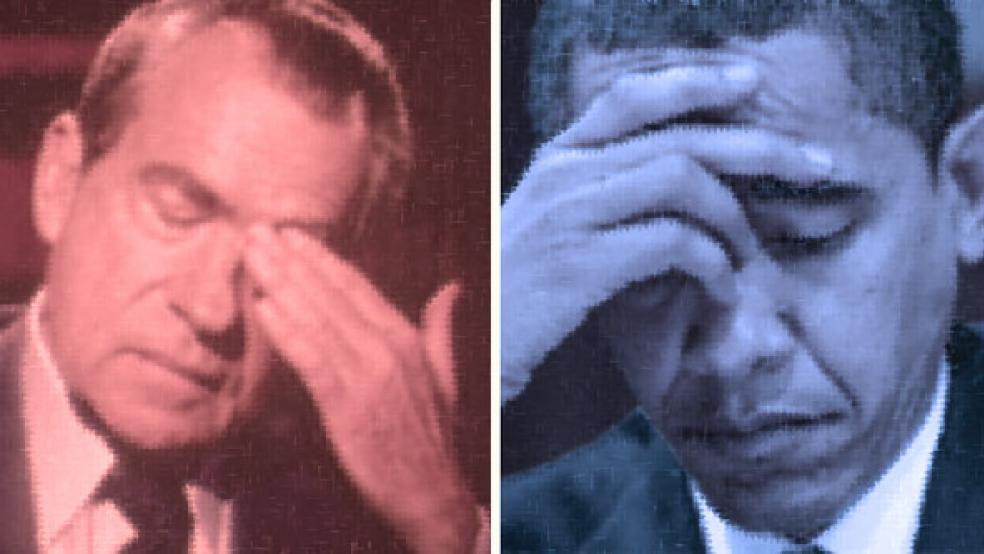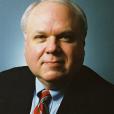As Barack Obama struggles to find his Presidential footing in the face of a weakening economy, tinderbox stock market, and hard-headed opposition, it is instructive to consider this: On August 15, 1971, Richard Nixon implemented the most radical economic program in American history. And it was all done over a single weekend in secrecy worthy of the atomic bomb project during World War II.
While ultimately unsuccessful, the Nixon program showed what a forceful president can do to completely change the nation’s course if he is willing to push the limit of his power.
The prelude to Nixon’s actions was that inflation had become a serious problem. From 1952 to 1965, inflation rarely ever went above 2 percent. But starting in 1966, it became worse and worse, rising from 1.6 percent in 1965 to 5.7 percent in 1970.
Lyndon Johnson’s advisers convinced him to impose a 10 percent income tax surcharge in 1968 to soak up purchasing power, but this had no effect on inflation whatsoever. Nixon’s advisers knew that the Federal Reserve could stop inflation by tightening monetary policy, but that would likely bring on a recession going into an election year. Nixon desperately needed to keep inflation bottled up until after the election.
Another concern was that the international monetary system was falling apart. Established at Bretton Woods in the aftermath of World War II, its foundation was having the dollar convertible to gold at $35 per ounce, with other currencies fixed to the dollar. But inflation was putting severe pressure on the exchange rate system and for 10 years American presidents had been fending off European demands to trade their dollars for our gold.
One way out of the inflation problem was wage and price controls. But the Nixon administration was officially opposed to them. On July 28, 1971, Council of Economic Advisers Chairman Paul McCracken wrote an op-ed article for The Washington Post denouncing wage and price controls in the strongest possible terms. They would undermine personal freedom, he said, and wouldn’t even work because there were too many prices, such as those for basic commodities, that couldn’t be controlled.
In mid-August, 1971, a crisis arose when Great Britain demanded $3 billion worth of gold (worth $150 billion at today’s gold price). This led Nixon to call a special meeting of his economic advisers at Camp David on Friday, August 13.
Years later, Sid Jones, who was McCracken’s assistant at the CEA, told me he knew something big was going on because McCracken came to him just before leaving for the weekend and gave him a letter designating him as acting CEA chairman for the weekend. Not only had McCracken never done such a thing before, but it wasn’t even appropriate because Jones wasn’t a member of the CEA; just a staffer. My guess is that McCracken wanted to be able to say later that he wasn’t technically chairman of the CEA when the ensuing events transpired.
At Camp David, Treasury Secretary John Connally, former governor of Texas (as a Democrat), was very much in charge. His main argument was that Nixon needed to be bold and do as much with one dramatic action as possible.
On Sunday, August 15, Nixon announced the imposition of wage and price controls throughout the U.S. economy, making dubious use of emergency presidential authority. He also closed the gold window and set the dollar free to float, destroying in one fell swoop the international monetary system that had existed for 25 years. Additionally, Nixon announced broad cuts in government spending, a 5 percent reduction in the federal workforce, a 10 percent surcharge on all tariffs, and a variety of other measures. (Compare that with more than six months of debt-ceiling debate that ended with no clear resolution.)
By and large, reaction to Nixon’s “New Economic Policy” was positive, especially among Democrats. Senate Majority Leader Mike Mansfield said he was “delighted.” Senator George McGovern said wage and price controls were “four years overdue.” Senator William Proxmire said, “The president has not only changed his game plan, but he has also reversed his field. I support his program.” Economist Arthur Okun, who chaired the CEA under Johnson, called the Nixon plan “a leap forward into realism.” The stock market recorded one of its best days in history on the following Monday.
But just as McCracken had warned, wage and price controls began to break down almost immediately. However, in the short run they did slow inflation’s upward momentum. The Consumer Price Index only rose 4.4 percent in 1971 – 1.3 percent less than the year before – and 3.1 percent in 1972. But as the controls were phased-out, inflation caught up with its underlying trend and rose 6.2 percent in 1973 and a shocking 11 percent in 1974. A key contributor was a big increase in the price of oil that the OPEC demanded to compensate its members for the steep fall in the dollar after 1971.
Although the policies announced on August 15, 1971, undoubtedly helped Nixon politically – he won an overwhelming victory in 1972 – they also undermined his position when their long-term consequences became evident. Catch-up inflation made that problem worse, forcing the Fed to sharply tighten monetary policy, which brought on a severe recession in 1974. This weakened Nixon politically when the Watergate scandal broke. He later told journalist Jude Wanniski that he thought he would have weathered it if the economy had been stronger.
In 1980, Connally ran for the Republican presidential nomination. At the time, I was working on Capitol Hill and he came to address a Republican staff group. Inflation was still a serious problem, but Connally insisted that under no circumstances should Washington consider wage and price controls. So I asked him why he had imposed them back in 1971. His answer, basically, was that while wage and price controls never worked, there was this one unique moment in history in which economic conditions were such that they might have worked. They didn’t because blah, blah, blah, whatever. No one in the audience found his answer convincing.
Perhaps the main long-term impact of Nixon’s 1971 policy was to discourage future presidents from acting aggressively and unilaterally on domestic issues. That may be one reason why Barack Obama resisted using the 14th Amendment to counter Republican extortion on the debt limit, as I believe he should have, and seems incapable of coming up with anything remotely bold to deal with the continuing economic crisis.






